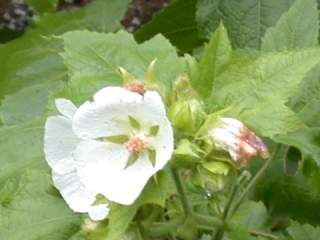 Introduction
IntroductionMalvaceae Info (Home)
Kitaibelia Gallery
 Introduction
Introduction
Kitaibelia Willd. is a genus of perennial herbs. There are 2 species, one of which is endemic to former Yugoslavia, and the other to Cilicia and the Levant. Two spellings of the generic name - Kitaibela and Kitaibelia - are in common use: Flora Europaea [1] uses the former, and IPNI [2] the latter. However the former seems to be a later orthographic variation due to Batsch.
The genus was named to honour Paul Kitaibel, a 19th century Hungarian botanist.
The genus does not have a vernacular English name in widespread use, but I have seen a few nursery web pages referring to it as Russian Hibiscus; however it is neither Russian nor a Hibiscus. Kitaibela (opposed to Kitaibelia) and Chalice have also been seen.
Classification
Kitaibelia was historically classified, with Malope and Palaua, in the tribe Malopeae, distinguished by the presence of a schizocarpous fruit with the mericarps arranged spirally or in several superimposed whorls. The tribe Malopeae is no longer accepted, and these genera are included in the tribe Malveae and sub-tribe Malvinae. This is confirmed by DNA sequencing.
The ITS DNA sequence shows Kitaibelia to be related to a clade containing Alcea and Althaea subgenus Althaea. Malope is more related closely related to Malva and Lavatera than to Kitaibelia, Alcea and Althaea, implying that the capitate fruits of Malope and Kitaibelia are convergent. The fruit characteristics of the South American genus Palaua are also convergent on Malope and Kitaibelia, and it is not closely related to Kitaibelia and Malope,
Technically Kitaibelia can be distinguished from Malope by the presence of 6-9 epicalyx segments, as opposed to the 3 epicalyx segments borne by Malope. In practice the Kitaibelia vitifolia is commonly a much bigger plant than species of Malope, and the white or pale pink flower colour of Kitaibelia constrasts with deep pink or purple flowers of Malope. In fruit the globose schizocarp serves to distinguish it from all remaining European mallows.
Kitaibelia was also made the type of the unranked taxon Kitaibelieae Rchb.
The genus was erected by Willdenow in 1799 for Kitaibelia vitifolia. Kitaibelia vitifolia is the only widely known species; however there is also a species Kitaibelia balansae Boiss. from Cilicia and the Levant. IPNI [2] also lists a Kitaibelia lindemuthi hort of hybrid origin. No information is available to me about this, but I suspect that it may be a selection from Kitaibelia vitifolia, rather than an interspecific hybrid.
Cytology:
Kitaibelia vitifolia is recorded as having 44 chromosomes.
Kitaibelia vitifolia Willd. Mohnmalve
Balkanmalva, Jättemalva
kitaibeelia
The natural distribution of Kitaibelia vitifolia is in former Yugoslavia, from south east Croatia and Voivoidina to northern Macedonia, where it is found in damp thickets and grassland.
It is a large perennial herb, variously described as growing to between 5 ft and 10 ft in height. The stems are robust, sparingly branched, and covered with stiff white hairs.
The leaves are borne on long petioles. The petioles are covered with stiff white hairs. The leaves are nearly hairless, up to 7" long, with 5-7 triangular, coarsely toothed, palmate lobes.
The inflorescence is a cyme of 1 to 4 flowers, borne, in mid-summer, in a leaf axil. Each flower is borne within an epicalyx of 6-9 segments, slightly connate at the base. The epicalyx segments are ovate-acuminate, and are slightly longer and wider than the sepals. The flowers are about 2" across. The white or pale pink petals form a shallow cup. Gaps between their bases allow the green calyx to be seen, which is perhaps the ‘unique selling point’ of the species as a horticultural subject. The petals are slightly longer than wide, obdeltate-cuneate in form, and with a rounded or slightly notched apex. The filiform stigmas are borne laterally.
The fruit is a schizocarp, consisting of numerous one-seeded mericarps arranged in around 5 superimposed whorls to form a depressed globose head. The hairy mericarps are dark brown, and dehiscent.
Cultivation
Kitaibelia vitifolia may be grown from seed, which should be sown, lightly covered, at 60°F, in spring or autumn. Germination normally takes 2-3 weeks. If sown in January or February flowers may be obtained in the first year.
The plant is best grown in sun or partial shade. Any soil is acceptable, but a dry situation is to be preferred.
Images
Synonyms:
Malope vitifolia (Willd.) Hegi is a synonyms of Kitaibelia vitifolia.
A tall herb, with hairy stems. The stipules are lanceolate. The leaves are more or less triangular, acute at the apex, and with coarsely and irregularly serrate margins. The flowers are borne, in later summer, solitarily in the leaf axils. The petals are red, and little longer than the sepals. The mericarps are densely hairy. When not in flower the lanceolate (not ovate) and triangular (not 3-lobed) leaves distinguish it from Kitaibelia vitifolia.
For many years this species was known only from the original mid 19th century collection, but it has been rediscovered, and seed has in the past been offered by the North American Rock Garden Society.
The species epithet honours the original collector.
References
If you have found any errors on this page, or have any further information about the genus Kitaibelia then please contact me at botany@malvaceae.info.
© 2002, 2003, 2006, 2007, 2008 Stewart Robert Hinsley